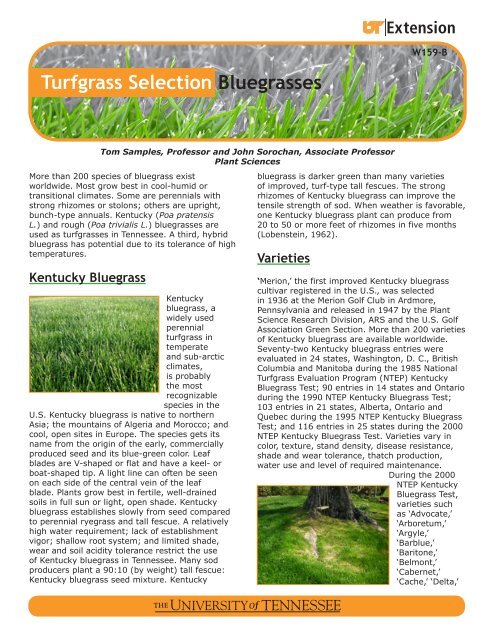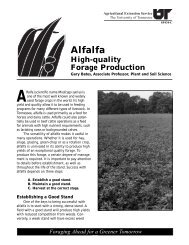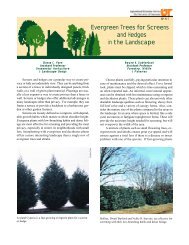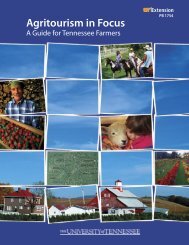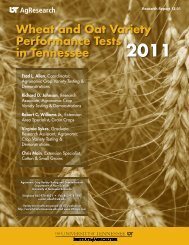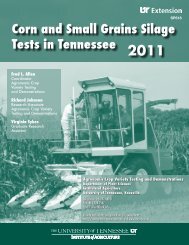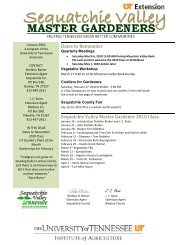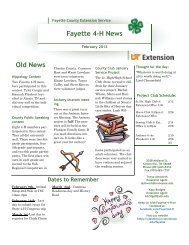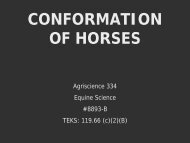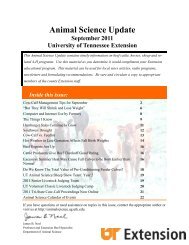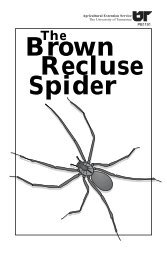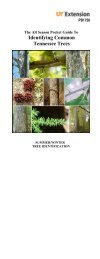Turfgrass Selection Bluegrasses - UT Extension - The University of ...
Turfgrass Selection Bluegrasses - UT Extension - The University of ...
Turfgrass Selection Bluegrasses - UT Extension - The University of ...
You also want an ePaper? Increase the reach of your titles
YUMPU automatically turns print PDFs into web optimized ePapers that Google loves.
<strong>Extension</strong><br />
W159-B<br />
<strong>Turfgrass</strong> <strong>Selection</strong> <strong>Bluegrasses</strong><br />
Tom Samples, Pr<strong>of</strong>essor and John Sorochan, Associate Pr<strong>of</strong>essor<br />
Plant Sciences<br />
More than 200 species <strong>of</strong> bluegrass exist<br />
worldwide. Most grow best in cool-humid or<br />
transitional climates. Some are perennials with<br />
strong rhizomes or stolons; others are upright,<br />
bunch-type annuals. Kentucky (Poa pratensis<br />
L.) and rough (Poa trivialis L.) bluegrasses are<br />
used as turfgrasses in Tennessee. A third, hybrid<br />
bluegrass has potential due to its tolerance <strong>of</strong> high<br />
temperatures.<br />
Kentucky Bluegrass<br />
Kentucky<br />
bluegrass, a<br />
widely used<br />
perennial<br />
turfgrass in<br />
temperate<br />
and sub-arctic<br />
climates,<br />
is probably<br />
the most<br />
recognizable<br />
species in the<br />
U.S. Kentucky bluegrass is native to northern<br />
Asia; the mountains <strong>of</strong> Algeria and Morocco; and<br />
cool, open sites in Europe. <strong>The</strong> species gets its<br />
name from the origin <strong>of</strong> the early, commercially<br />
produced seed and its blue-green color. Leaf<br />
blades are V-shaped or flat and have a keel- or<br />
boat-shaped tip. A light line can <strong>of</strong>ten be seen<br />
on each side <strong>of</strong> the central vein <strong>of</strong> the leaf<br />
blade. Plants grow best in fertile, well-drained<br />
soils in full sun or light, open shade. Kentucky<br />
bluegrass establishes slowly from seed compared<br />
to perennial ryegrass and tall fescue. A relatively<br />
high water requirement; lack <strong>of</strong> establishment<br />
vigor; shallow root system; and limited shade,<br />
wear and soil acidity tolerance restrict the use<br />
<strong>of</strong> Kentucky bluegrass in Tennessee. Many sod<br />
producers plant a 90:10 (by weight) tall fescue:<br />
Kentucky bluegrass seed mixture. Kentucky<br />
bluegrass is darker green than many varieties<br />
<strong>of</strong> improved, turf-type tall fescues. <strong>The</strong> strong<br />
rhizomes <strong>of</strong> Kentucky bluegrass can improve the<br />
tensile strength <strong>of</strong> sod. When weather is favorable,<br />
one Kentucky bluegrass plant can produce from<br />
20 to 50 or more feet <strong>of</strong> rhizomes in five months<br />
(Lobenstein, 1962).<br />
Varieties<br />
‘Merion,’ the first improved Kentucky bluegrass<br />
cultivar registered in the U.S., was selected<br />
in 1936 at the Merion Golf Club in Ardmore,<br />
Pennsylvania and released in 1947 by the Plant<br />
Science Research Division, ARS and the U.S. Golf<br />
Association Green Section. More than 200 varieties<br />
<strong>of</strong> Kentucky bluegrass are available worldwide.<br />
Seventy-two Kentucky bluegrass entries were<br />
evaluated in 24 states, Washington, D. C., British<br />
Columbia and Manitoba during the 1985 National<br />
<strong>Turfgrass</strong> Evaluation Program (NTEP) Kentucky<br />
Bluegrass Test; 90 entries in 14 states and Ontario<br />
during the 1990 NTEP Kentucky Bluegrass Test;<br />
103 entries in 21 states, Alberta, Ontario and<br />
Quebec during the 1995 NTEP Kentucky Bluegrass<br />
Test; and 116 entries in 25 states during the 2000<br />
NTEP Kentucky Bluegrass Test. Varieties vary in<br />
color, texture, stand density, disease resistance,<br />
shade and wear tolerance, thatch production,<br />
water use and level <strong>of</strong> required maintenance.<br />
During the 2000<br />
NTEP Kentucky<br />
Bluegrass Test,<br />
varieties such<br />
as ‘Advocate,’<br />
‘Arboretum,’<br />
‘Argyle,’<br />
‘Barblue,’<br />
‘Baritone,’<br />
‘Belmont,’<br />
‘Cabernet,’<br />
‘Cache,’ ‘Delta,’
‘Fylking,’ ‘Harmony,’ ‘Kenblue,’ ‘Kimono,’ ‘Mesa,’<br />
‘Monopoly,’ ‘Newport,’ ‘Parade,’ ‘Park,’ ‘Parkland,’<br />
‘Piedmont,’ ‘Plush,’ ‘Sonoma,’ ‘South Dakota,’<br />
‘Vantage,’ ‘Vanessa,’ ‘Victa’ and ‘Wabash’ grew<br />
upright, were more susceptible to disease and<br />
generally required less maintenance than other,<br />
lower-growing varieties. <strong>The</strong> varieties ‘Absolute,’<br />
‘Alpine,’ ‘America,’ ‘Argos,’ ‘Bensun,’ ‘Bluemoon,’<br />
‘Bristol,’ ‘Eclipse,’ ‘Glade,’ ‘Impact,’ ‘Marquis,’<br />
‘Merit,’ ‘Midnight,’ ‘Nugget,’ ‘NuGlade,’ ‘Ram I’ and<br />
‘Sebring’ demonstrated improved shade tolerance.<br />
<strong>The</strong> 2005 NTEP Kentucky Bluegrass Test is being<br />
conducted at the <strong>University</strong> <strong>of</strong> Tennessee Knoxville<br />
Research and Education Center.<br />
Varietal Categories and<br />
Classifications<br />
Kentucky<br />
bluegrasses are<br />
grouped into<br />
three general<br />
categories: I.<br />
Elite turf types;<br />
II. BVMG turf<br />
types; and III.<br />
Common types.<br />
Before the<br />
variety Merion<br />
was released<br />
in 1947, Common-type Kentucky bluegrasses<br />
(Category III) were the major type used for turf<br />
in the United States. Classifications <strong>of</strong> the turftype<br />
Kentucky bluegrasses (Categories I and II)<br />
include Aggressive, Bellevue, Compact, Compact-<br />
America, Compact-Midnight, Julia, Mid-Atlantic and<br />
Shamrock types.<br />
<strong>The</strong> following classifications are summarized<br />
from charts presented by Dr. Leah Brilman,<br />
Seed Research <strong>of</strong> Oregon (http://www.sroseed.<br />
com/resources/pdfs/KentBlueClass_06.pdf), from<br />
personal observations and Rutgers <strong>University</strong><br />
<strong>Turfgrass</strong> Proceedings. Performance and<br />
persistence may vary greatly among varieties<br />
within the same classification. This information is<br />
intended to categorize varieties according to traits<br />
and is not a list <strong>of</strong> varieties recommended for use<br />
in Tennessee.<br />
Aggressive. This group <strong>of</strong> Kentucky bluegrasses<br />
is noted for good wear tolerance, dense aerial<br />
shoots and an accelerated lateral growth rate.<br />
Although they may eventually dominate a<br />
Kentucky bluegrass blend, these varieties <strong>of</strong>ten<br />
perform well as sports turfs. ‘A-34,’ ‘Bariris,’<br />
‘Brunswick,’ ‘Cheetah,’ ‘Julius,’ ‘Limousine,’ ‘Mystic,’<br />
‘Northstar,’ ‘Orfeo,’ ‘P-104’ and ‘Touchdown’<br />
are examples <strong>of</strong> aggressive-type Kentucky<br />
bluegrasses.<br />
Bellevue. Bellevue-type Kentucky bluegrasses<br />
generally green-up early and are ‘stemmy’ in<br />
spring, have medium-wide leaves, and resist leaf<br />
spot and stripe smut. <strong>The</strong> aerial shoot density<br />
<strong>of</strong> varieties in this class is lower than those<br />
in many <strong>of</strong> the other classes. <strong>The</strong>se Kentucky<br />
bluegrasses usually have excellent winter color.<br />
‘Banff,’ ‘Bellevue,’ ‘Classic,’ ‘Dawn,’ ‘Freedom,’<br />
‘Georgetown,’ ‘Haga,’ Parade and ‘Trenton’ are<br />
Bellevue-type Kentucky bluegrasses.<br />
CELA / ‘Challenger,’ Eclipse, ‘Liberty’ and<br />
‘Adelphi.’ During spring green-up, the overall<br />
turfgrass quality <strong>of</strong> varieties in this class is<br />
generally better than that <strong>of</strong> the compact types.<br />
<strong>The</strong>se varieties are resistant to leaf spot and stripe<br />
smut, and are usually less stemmy than Bellevue.<br />
Winter performance varies among the CELAtype<br />
Kentucky bluegrasses. Challenger, Eclipse,<br />
‘Jefferson,’ Liberty, and ‘Rambo’ are CELA-type<br />
Kentucky bluegrasses.<br />
Cheri. Characteristics <strong>of</strong> Cheri-type Kentucky<br />
bluegrasses include good overall turfgrass quality,<br />
medium leaf width and stand density, mediumlow<br />
growth, good sod strength and stripe smut<br />
resistance, and moderate winter dormancy. <strong>The</strong>se<br />
varieties <strong>of</strong>ten yield large quantities <strong>of</strong> seed<br />
and are less stemmy than BVMG-type Kentucky<br />
bluegrasses. <strong>The</strong> varieties ‘Cheri,’ ‘Cobalt,’<br />
‘Serene’ and ‘Sydsport’ are Cheri-type Kentucky<br />
bluegrasses.<br />
Compact. <strong>The</strong>se varieties are generally<br />
lower-growing and more compact than other<br />
bluegrasses. Compact types tend to resist leaf<br />
spot and, when maintained at a 1/2-inch mowing<br />
height, can be very high in overall turfgrass<br />
quality. Plants may turn purple while dormant in<br />
winter. Persistence and summer performance vary<br />
among varieties in this class. ‘Amazon,’ ‘Apex,’<br />
‘Ascot,’ ‘Blacksburg,’ ‘Blackstone,’ ‘Blue Maxx,’<br />
‘Blue-tastic,’ ‘Broadway,’ ‘Chicago II,’ ‘Diva,’ Glade,<br />
‘Goldstar,’ ‘Golden Nugget,’ ‘Hallmark,’ ‘Indigo,’<br />
‘Moonlight,’ ‘Moonshadow,’ ‘Nugget, ‘Platini,’<br />
‘Ram 1,’ ‘Skye’ and ‘Wildwood’ are examples <strong>of</strong><br />
compact-type Kentucky bluegrasses.<br />
Compact America. <strong>The</strong>se varieties share<br />
characteristics <strong>of</strong> the Compact-type Kentucky<br />
bluegrasses, are dense, have fine leaf texture and<br />
tolerate medium shade. <strong>The</strong>y usually recover well<br />
from winter dormancy, and resist powdery mildew<br />
and summer patch. America, ‘Apollo,’ ‘Arrow,’<br />
‘Bedazzled,’ ‘Bordeaux,’ ‘Boutique,’ ‘Brilliant,’<br />
‘Dynamo,’ ‘Glenmont,’ ‘Kingfisher,’ ‘Langara,’
‘Mallard,’ ‘Royale,’ ‘Showcase,’ ‘SR2284,’ Sonoma<br />
and ‘Unique’ are classified as Compact-Americatype<br />
Kentucky bluegrasses.<br />
Compact Midnight. Varieties in the Compact-<br />
Midnight Class share those characteristics <strong>of</strong> the<br />
Compact Class, are very dark green and, although<br />
they don’t usually resume growth until late spring,<br />
tolerate high temperatures. <strong>The</strong>se varieties may<br />
be susceptible to powdery mildew, summer patch<br />
and rust. Absolute, ‘Alexa,’ ‘Arcadia,’ ‘Award,’<br />
‘Awesome,’ ‘Barrister,’ ‘Beyond,’ ‘Blue Velvet,’<br />
‘Bluestone,’ ‘Courtyard,’ ‘Everest,’ ‘EverGlade,’<br />
‘Excursion,’ ‘Freedom II,’ ‘Freedom III,’ ‘Ginney,’<br />
Impact, Liberator, Midnight, ‘Midnight II,’ ‘Midnight<br />
Star,’ ‘NuDestiny,’ NuGlade, ‘Odyssey,’ ‘Perfection,’<br />
‘Quantum Leap,’ ‘Rugby II,’ ‘Rhythm,’ ‘Total<br />
Eclipse’ and ‘Tsunami’ are Compact-Midnight-type<br />
Kentucky bluegrasses.<br />
Julia. <strong>Bluegrasses</strong> in this category are usually<br />
wear-tolerant, dense, high in overall turfgrass<br />
quality, and resistant to leaf spot and stripe smut.<br />
Most perform well in the summer. <strong>The</strong> varieties<br />
‘Avalanche,’ ‘Rampart’ and ‘Ulysses’ have improved<br />
brown patch and dollar spot resistance. ‘Caliber,’<br />
‘Ikone’ and ‘Julia’ are also Julia-type Kentucky<br />
bluegrasses.<br />
Mid-Atlantic. Varieties in this class are valued for<br />
their vigorous growth rate, strong rhizomes and<br />
extensive root systems. <strong>The</strong>y usually perform well<br />
in winter, green-up in early spring, are tolerant<br />
<strong>of</strong> summer stresses and recover quickly from<br />
disease. <strong>The</strong> variety ‘Preakness’ has improved leaf<br />
spot resistance. Other Mid-Atlantic types include<br />
Cabernet, ‘Eagleton,’ ‘Livingston,’ Monopoly, Plush<br />
and Wabash.<br />
Shamrock. Strong, well-developed rhizomes<br />
contribute to the improved sod strength and<br />
good overall turfgrass quality <strong>of</strong> these Kentucky<br />
bluegrasses. Shamrock-type Kentucky bluegrasses<br />
generally resist leaf spot, maintain green color<br />
during winter, are less stemmy than BVMG types<br />
and produce large amounts <strong>of</strong> seed. Summer<br />
performance varies among varieties. ‘Atlantis,’<br />
‘Brooklawn,’ ‘Champagne,’ ‘Champlain,’ ‘Durham,’<br />
‘Lakeshore,’ Mongoose,’ ‘Moonshine,’ Parkland,<br />
‘Shamrock’ and ‘SR2100’ are Shamrock-type<br />
Kentucky bluegrass varieties.<br />
Other. Additional research is needed to classify<br />
varieties in this group. <strong>The</strong> characteristics <strong>of</strong> these<br />
varieties are most <strong>of</strong>ten intermediate among the<br />
other classes. ‘Allure,’ ‘Ascot,’ ‘Baronie,’ ‘Bartitia,’<br />
Barisis,’ Baritone, ‘Baruzo,’ ‘Blackstone,’ ‘Blue<br />
Ridge,’ ‘Bronco,’ ‘Canterbury,’ ‘Chicago,’ ‘Cardiff,’<br />
‘Chateau,’ ‘Chelsea,’ ‘Compact,’ ‘Coventry,’<br />
‘Cynthia,’ ‘Explorer,’ ‘Jewel,’ ‘Lily,’ ‘Markham,’<br />
‘Misty,’ ‘Monte Carlo,’ ‘NuStar,’ ‘Rita,’ ‘Sebring,’<br />
‘Sodnet,’ ‘Washington and ‘Yvette’ are examples <strong>of</strong><br />
varieties in this class.<br />
BVMG / ‘Baron,’ Victa, Merit, & ‘Gnoma.’<br />
Kentucky bluegrasses in this class have mediumwide<br />
leaves, a medium-low plant height and<br />
usually yield large amounts <strong>of</strong> seed. Many <strong>of</strong> these<br />
varieties may be prone to stripe smut. Turfs <strong>of</strong><br />
BVMG Kentucky bluegrasses tend to be ‘stemmy’<br />
and perform poorly during cold winter months.<br />
‘Abbey,’ Baron, ‘BlueChip,’ ‘BlueStar,’ ‘Cannon,’<br />
‘Clearwater,’ ‘Crest,’ ‘Dragon,’ ‘Envicta,’ ‘Fortuna,’<br />
Gnoma, ‘Goldrush,’ Marquis, Merit, ‘Nassau,’<br />
‘Raven,’ and Victa are classified as BVMG-type<br />
Kentucky bluegrasses.<br />
Common. <strong>The</strong>se upright, narrow-leaf varieties<br />
are <strong>of</strong>ten used to stabilize and conserve soils in<br />
the Midwest. High temperatures and drought may<br />
induce summer dormancy. Many Common-type<br />
Kentucky bluegrasses set seed earlier than other<br />
varieties. Plants are usually prone to leaf spot and<br />
discolor during cold winter months. ‘Alene,’ Argyle,<br />
Cache, ‘Garfield,’ ‘Geary,’ ‘Ginger,’ ‘Greenley,’<br />
‘Huntsville,’ Kenblue, Newport, Park, Piedmont,<br />
‘Ronde,’ ‘S-21,’ South Dakota, ‘Voyager’ and<br />
‘Wellington’ are classified as Common Kentucky<br />
bluegrasses.<br />
Seed Blends<br />
Most seed<br />
distributors in<br />
Tennessee study<br />
the performance<br />
<strong>of</strong> individual<br />
varieties<br />
entered in the<br />
NTEP Kentucky<br />
Bluegrass Test.<br />
Many blend<br />
only those<br />
varieties that<br />
are compatible and perform best at sites located<br />
in the northern turfgrass transition zone. Turf<br />
quality <strong>of</strong>ten suffers when mid-level-performing<br />
Kentucky bluegrass varieties are blended with<br />
high-performance varieties. Similarly, blending an<br />
aggressive, medium-dense, medium-green variety<br />
developed with sports turfs in mind with a slowgrowing,<br />
dark-green and compact variety intended<br />
for use on dense, intensely managed golf course<br />
fairways and lawns <strong>of</strong>ten results in a problematic,<br />
non-uniform turf.
Rough Bluegrass<br />
Rough bluegrass, also referred to as roughstalk<br />
bluegrass, is a native <strong>of</strong> northern Europe. This<br />
yellow-green, fine-textured species produces<br />
stolons and is more tolerant <strong>of</strong> low temperatures<br />
and shade than Kentucky bluegrass. Rough<br />
bluegrass has poor heat and drought tolerance<br />
and is usually short-lived in the South, where<br />
it is sometimes used as a component <strong>of</strong> seed<br />
mixtures for shade and for over-seeding dormant<br />
bermudagrass. Rough bluegrass can occur as<br />
a weed, particularly during summer, on sites<br />
receiving full sunlight. Improved varieties include<br />
‘Barivierra,’ ‘Colt,’ ‘Cypress,’ ‘Laser,’ ‘Proam,’<br />
‘Sabre,’ ‘Sabre II,’ ‘Snowbird’ and ‘Winterplay.’<br />
Hybrid Bluegrass<br />
<strong>Turfgrass</strong><br />
breeders<br />
have recently<br />
developed<br />
hybrid<br />
bluegrass,<br />
commonly<br />
referred to as<br />
heat-tolerant or<br />
HT bluegrass,<br />
from a heatand<br />
droughttolerant<br />
species<br />
<strong>The</strong>rmal Blue HT Bluegrass<br />
(Poa arachifera Torr.) that is native to Texas and<br />
Kentucky bluegrass (Poa pratensis L.). ‘Reveille,’<br />
the first hybrid between Texas and Kentucky<br />
bluegrass registered in the U.S., was released<br />
(Texas AES) in 2000. <strong>The</strong> variety was developed<br />
by Dr. James Read in 1990 from a Texas bluegrass<br />
plant found in a remnant prairie near Dallas, TX<br />
and ‘Huntsville’ Kentucky bluegrass. Reveille is a<br />
medium-textured, medium-green variety that is<br />
resistant to powdery mildew and fall armyworms.<br />
It is susceptible to brown patch and is moderately<br />
resistant to rust. Reveille is well-adapted to<br />
lawns in southern Oklahoma and central Texas<br />
maintained at a mowing height from 1½ to 2½<br />
inches and fertilized with 4 to 6 pounds <strong>of</strong> N per<br />
1,000 sq. ft. annually. <strong>The</strong> water requirement <strong>of</strong><br />
Reveille is similar to ‘Common’ bermudagrass.<br />
Reveille is more tolerant <strong>of</strong> heat and drought<br />
than many turf-type tall fescues and performs<br />
similarly in shade. A recent release, ‘<strong>The</strong>rmal Blue’<br />
(<strong>The</strong> Scotts Company), has relatively wide leaves<br />
and maintains quality with minimal N fertility,<br />
water and maintenance intensity. <strong>The</strong>rmal Blue is<br />
similar in overall quality to the Kentucky bluegrass<br />
varieties ‘Coventry,’ ‘Jefferson,’ ‘Limousine’<br />
and ‘Baronie.’ <strong>The</strong> leaf texture <strong>of</strong> <strong>The</strong>rmal Blue<br />
resembles that <strong>of</strong> medium-coarse textured<br />
varieties <strong>of</strong> Kentucky bluegrass such as Abbey,<br />
‘Blacksburg II,’ Moonlight and Raven. Other hybrid<br />
bluegrasses now available include ‘Bandera,’ ‘Dura<br />
Blue,’ Fahrenheit 90,’ ‘Fire and Ice,’ ‘Longhorn,’<br />
‘Solar Green’ and ‘<strong>The</strong>rmal Blue Blaze.’<br />
References<br />
Bonos, S. A., W. A. Meyer and J. A. Murphy. 2007.<br />
Choose Kentucky Bluegrass Types to Develop<br />
Improved Blends, <strong>Turfgrass</strong> Trends, 4 pp.<br />
http://www.turfgrasstrends.com/turfgrasstrends/<br />
article/articleDetail.jsp?id=12799<br />
Bonos, S. A., W. A. Meyer, and J. A. Murphy. 2000.<br />
“Classification <strong>of</strong> Kentucky Bluegrass Genotypes<br />
Grown as Spaced-plants.” Hort. Sci. 35(5):910-913.<br />
Brede, A. D. 2004. Blending Kentucky Bluegrass<br />
Cultivars <strong>of</strong> Different Quality Performance Levels.<br />
CSSA, Madison, WI, Crop Sci. 44:561-566.<br />
Lobenstein, C. W. 1962. Proceedings <strong>of</strong> the<br />
Midwest Regional Turf Conference.<br />
Visit the <strong>UT</strong> <strong>Extension</strong> Web site at<br />
http://www.utextension.utk.edu/<br />
W159B-9/07<br />
Copyright 2007 <strong>The</strong> <strong>University</strong> <strong>of</strong> Tennessee. All rights reserved. This document<br />
may be reproduced and distributed for nonpr<strong>of</strong>it educational purposes<br />
providing that credit is given to <strong>University</strong> <strong>of</strong> Tennessee <strong>Extension</strong>.<br />
Programs in agriculture and natural resources, 4-H youth development, family and consumer<br />
sciences, and resource development. <strong>University</strong> <strong>of</strong> Tennessee Institute <strong>of</strong> Agriculture, U.S.<br />
Department <strong>of</strong> Agriculture and county governments cooperating.<br />
<strong>UT</strong> <strong>Extension</strong> provides equal opportunities in programs and employment.


